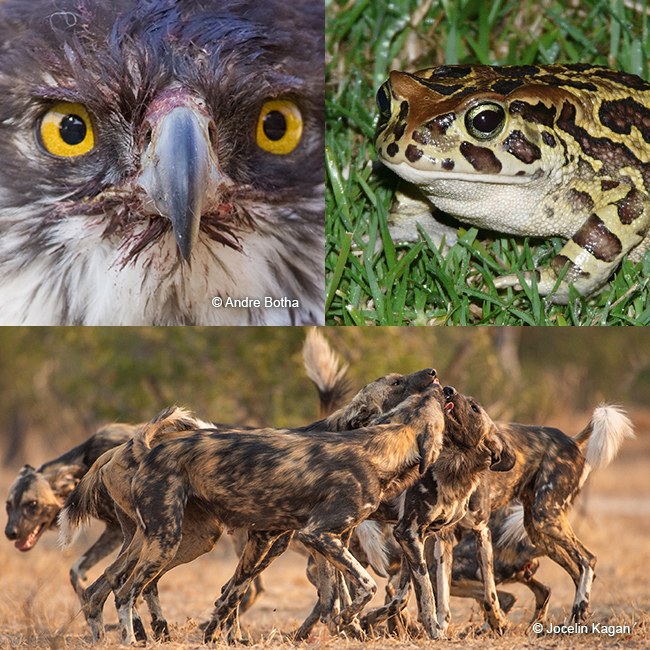threatened species
no-go mapping tool

Background
South Africa is considered one of the most biologically diverse countries in the world. It has a high rate of endemism and diverse ecosystems. While it occupies only 2% of the world’s land surface area, South Africa is home to over 95,000 species, contributing a significant proportion to world plant species (6%), reptile species (5%), bird species (8%) and mammal species (6%), with more species regularly discovered and described. To conserve this biodiversity, it is important to understand which areas are considered threatened species no-go areas.
The Department of Forestry, Fisheries, and the Environment (DFFE) has established an online, open-access national Environmental Screening Tool (EST). Since 5 July 2019, by law, a report generated by the screening tool must accompany all environmental impact assessments (EIAs).
The EWT’s mapping tool
Using the underlying data from the EST the Endangered Wildlife Trust has created a threatened species no-go mapping tool that builds on the foundation of the environmental screening tool to fill a number of important gaps but primarily to identify areas of significant biodiversity impact, especially for species of conservation concern, if a development was to be approved. These Threatened Species No-Go areas not legally mandated by DFFE but should be considered as priority areas to avoid, as the first port of call, for any prospective developer, given their high sensitivity.
The tool screens for a broad range of environmental sensitivities, including terrestrial plant and animal biodiversity. The South African Biodiversity Institute, the Endangered Wildlife Trust, and BirdLife South Africa have collaborated to develop the species data that feeds into the screening tool. The criteria for inclusion of a species is that it is a species of conservation concern listed on the IUCN Red List of Threatened Species or South Africa’s National Red List website as Critically Endangered, Endangered, or Vulnerable according to the IUCN Red List 3.1. Categories and Criteria. There are currently over 422 animal and 4,600 plant species represented in the screening tool.
Using the no go tool

The Department of Forestry, Fisheries, and the Environment’s Environmental Screening Tool
The DFFE’s screening tool was created to:
- streamline and simplify the EIA process by providing timeous, succinct, and robust reports
- ensure ongoing improvements to the efficiency and effectiveness of the EIA process
- enable applicants to avoid sensitive sites by manipulating the development footprint on a site, to avoid environmental sensitivities
- identify upfront any specific exclusions, restrictions, prohibitions or exceptions to the EIA process that apply to a particular site.
- The screening tool also informs early-stage decisions around avoidance, minimisation, specialist requirements and, in some cases, it facilitates early rejection which ultimately saves money and effort.
Download the gazetted protocol for the assessment and reporting of environmental impacts on terrestrial animal and plant species.

Purpose
This is a national scale application which informs prospective developers, Environmental Assessment practitioners and/or the general public about areas of very high sensitivity biodiversity importance based on threatened animal and plant data. The intended purpose of the tool is to inform the placement of proposed potentially detrimental developments in order to encourage early-stage rejection or avoidance before EIA commencement and in this way avoid unnecessary cost to the developer, the responding interested and affected parties (especially conservation agencies), and as a result reduce irreversible loss/risk to the environment. There has been hesitancy to identify areas which are highly unsuitable for development and this application aims to address this directly. This online app allows for rapid assessment of site sensitivity to inform the first stage of the mitigation hierarchy, that being avoidance. The tool is intended to be a reference tool for prospective developers, EAPs and I&APs and should be used utilized in the project design stage to inform placement of development options and alternatives.

HOW IT WORKS
Basic instructions
Accessing the map
To get started, click on the “Interactive map” menu item in the sidebar. The default view of the map displays all of the threatened species no-go areas. Zoom in to look at these features more closely. Hover over the feature to display more information.
Viewing layers
The panel on the right shows a number of layers that can be toggled on/off. At the top are three base layers showing either a topographic, street, or satellite imagery view. Below those are the data layers which include the no-go areas, which can be turned on/off, the protected area layers and the farm portions, and ERFS from the cadastral data.
Running queries
There are four ways to query the map with your own spatial data: you can either upload a shapefile/KML file, enter a Survey General 21 digit property code, enter a latitude or longitude point, or manually draw a polygon directly on the map.
In order to view further details about the species that are flagged as no-go and the properties that they occur in, click on the “Data table outputs” sidebar menu item.
This page has four tabs that correspond to each of the spatial input methods. Click on each one as needed. Each tab has a “Species” table, where details of the no-go species are listed, and a “Property” table, which contains the details of properties in which a species or group of species is found. The download button can be used to export the tables in an Excel CSV format.
There is also an option to plot all of the no-go polygons of a specific species. Navigate back to the “Interactive map” sidebar menu item and scroll to the “Species” dropdown list. Here you can either select a species from the list or start typing to bring up the matching species. Click plot to view the entire species layer, which can also be toggled on/off.

WHO SHOULD USE THIS TOOL?
In this threatened species no-go area tool we build on the foundation of the environmental screening tool to fill a number of important gaps. The No-Go areas are informed by the same underlying data that inform the EST but only the most sensitive subset of these. The resultant No-Go areas should be treated as priorities for avoidance given their importance for conserving highly localized species of conservation concern. The EST does not explicitly highlight these areas from a development avoidance perspective but due to their level of sensitivity, this tool provides an easily accessed and user-friendly portal for prospective developers, Competent Authorities and Environmental Assessment Practitioners to identify No-Go Areas at the onset of the scoping phase for any given development. It also allows the easy identification of alternative sites, through the ability to assess landscapes including multiple properties, to avoid No-Go Areas. This is also a useful tool for identifying species focused protected area expansion priorities for conservation authorities and NGOs.

How are no go areas defined?
The data included in this national scale map are a subset of the data included in the EST terrestrial animal and plant sensitivity layers. We followed a three-step process to filter the screening tool data in order to identify our threatened species no-go areas.
First, we included only data from the Very High or High sensitivity categories.
Second, we kept only species which were Red Listed under the IUCN’s criteria B, C, and D. This ensures that the species included are facing threats directly related to habitat transformation and loss.
Third, we calculated the total geographic area of the polygons in the screening tool layers and retained species which had a total of less than or equal to 25km2. This therefore identifies species for which we have confirmed occurrence records from an extremely restricted area. Not all species are included in the EST tool and the No-Go tool, and thus users should not assume that an absence on a No-Go report necessarily reflects a true absence in the field.

Species summaries
| Number of species in each group included in the no-go map | ||
| Theme | Class or taxa | Number of species |
| Animals | Amphibia | 15 |
| Animals | Arachnida | 4 |
| Animals | Aves | 2 |
| Animals | Insecta | 59 |
| Animals | Invertebrate | 5 |
| Animals | Mammalia | 20 |
| Animals | Reptilia | 7 |
| Plants | 1747 | |

Sensitivity levels
The spatial data in the mapping tool are assigned one of two sensitivity levels:
Areas of Very High sensitivity represent critical habitat for range-restricted species of conservation concern that have a global range of less than 10 km2.
High sensitivity areas are those with recent (post-2002) confirmed habitat for species of conservation concern

contribute
Please contribute your data to improve and maintain the EST and No-Go tools
Any records of threatened species collected during EIAs and by specialists during surveys are of high value in terms of developing species distribution models and understanding the range of our threatened species. Based on the gazetted species protocol, species records need to be uploaded onto a virtual museum platform. This is not yet available. However, in the interim records can be directly submitted emailing us on the link below.
You are the experts and we value your input to improve the robustness of this tool.
* The EWT will compile all external data submitted into a central database which will be shared with SANBI and will be incorporated into the EST. Data housed on the EWT database can be accessed via a data request.

Help and resources
- Environmental Screening Tool
- Government Gazette of the Terrestrial Plant Species and Terrestrial Animal Species protocols
- Species environmental assessment guideline: Guidelines for the implementation of the Terrestrial Flora (3c) & Terrestrial Fauna (3d) Species Protocols for environmental impact assessments in South Africa
- Understanding SG codes – http://csg.dla.gov.za/21charac.htm
- Endangered Wildlife Trust – https://ewt.org
- SANBI – https://www.sanbi.org/
For suggestions, queries, or to report bugs please email us on the link below
Data Disclaimer
This tool is based on biodiversity data alone and does not inform No-Go areas on the basis of other triggers such as cultural heritage or ecosystem services. Even though we are fortunate to have access to one of the world’s most robust and comprehensive biodiversity datasets, we recognise that, in some instances, species presence data may be outdated as shifts in landuse or species distribution may have occurred within the past twenty years. In these instances, we would value the submission of updated data to improve the tool to be emailed to us.
